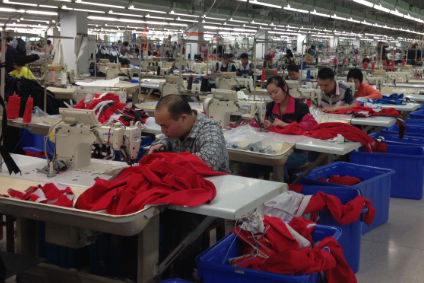EU clothing imports from China continue to plunge
Aug 25, 2016

EU clothing imports from China plunged nearly 10% in volume the first three months of 2016
of 2016
EU clothing imports from China plunged in volume by 9.9% in the first three months of 2016 compared with the same period last year, according to a new report.
The fall followed a 12.5% decline across the whole of 2015, which dragged imports down to their lowest level since 2006, says the report, which features in the latest issue of Global Apparel Markets from business information company Textiles Intelligence.
The declines in both periods represented the steepest falls among the EU's ten largest clothing suppliers. As a result, China's share of EU clothing imports from all sources declined in both periods, from 43.3% in 2014 to just 35.1% in the first three months of 2016.
Admittedly, China remained by far the EU's largest clothing supplier in the first three months of 2016 but a number of other countries gained market share.
EU clothing imports from Bangladesh, for example, rose by 4.2% in the whole of 2015 and were up by 8.0% in the first three months of 2016. As a result, Bangladesh's share of EU clothing imports from all sources in the latter period reached 24.6%.
Meanwhile, EU clothing imports from Cambodia shot up by 12.6% in 2015 and were up by 17.7% in the first three months of 2016; EU clothing imports from Pakistan rose by 6.5% in 2015 and were up by 8.4% in the first three months of 2016; and EU clothing imports from Vietnam increased by 3.2% in 2015 and were up by 1.6% in the first three months of 2016.
This apparent shift in sourcing from China to other countries in Asia reflects the fact that several companies in China have moved, or plan to move, at least some of their clothing production to other countries in order to benefit from abundant supplies of cheaper labour.
In particular, many Chinese companies are opting to move to countries in Southeast Asia where wages are lower than in China. In Cambodia, for instance, the average wage for garment workers is only a fifth of that in China, while in Myanmar the average wage is even lower than that in Cambodia.
As well as the benefit of cheaper labour, a number of exporting countries in Southeast Asia and South Asia benefit from preferential trade agreements with the EU and the US, the world's two biggest import markets, whereas China does not.
Manufacturers in Bangladesh, Cambodia and Myanmar, for example, benefit from duty-free access to the EU through the EU's Generalised Scheme of Preferences (GSP) Everything But Arms (EBA) arrangement.
And manufacturers in Vietnam stand to gain from improved access to the EU import market once the EU-Vietnam free trade agreement comes into force.
Having said that, the average price of EU clothing imports from China was the third lowest among the EU's leading ten suppliers in 2015.
Furthermore, during the first three months of 2016 the average price of EU clothing imports from China fell by 0.3%, while the average prices of imports from Bangladesh, Cambodia, Myanmar and Vietnam all rose noticeably.
Such competitiveness stems from the fact that productivity in China is superior to that enjoyed by its counterparts in South-East Asia and South Asia. Also, China has a much better infrastructure than most other major clothing manufacturing countries in Asia. As a result, its supply chain is more efficient and manufacturers in the country are able to guarantee timely delivery of their products.
Source: just-style
Hot Stories
Copyright © 2017, G.T. Internet Information Co.,Ltd. All Rights Reserved.